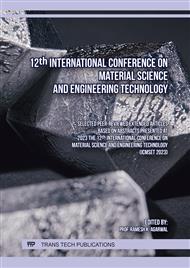p.85
p.95
p.103
p.109
p.115
p.123
p.129
p.135
p.141
Optimization of µ-WEDM Parameters for MRR and SR on Ti-6Al-4V
Abstract:
Micro EDM is unconventional metal removing technique that is effective in machining hard-to-cut conductive materials. It has a big potential in modifying surfaces of metallic bone implants for better biocompatibility by providing proper surface topography to ease cell adhesion. However, it is still important to study machining performance. This paper investigates material removal rate (MRR) and surface roughness (SR) of micro WEDM on Ti-6Al-4V alloy. Three level Taguchi’s design was implemented to observe the effect of capacitance and gap voltage. Moreover, analysis of variance (ANOVA) and grey relation analysis (GRA) allowed to investigate contribution of each parameter and find their best combination for multiple output optimization. Results showed that highest MRR of 1.72*10-2 mm3/s can be achieved at 10 nF and 90 V values, while smallest SR of 0.309 µm can be achieved at 1nF and 90 V. In addition, the contribution and significance of capacitance on MRR and SR was considerably higher than the effect of gap voltage. Lastly, the optimal parameters for multiple output performance were calculated at 10 nF and 90 V values.
Info:
Periodical:
Pages:
115-121
Citation:
Online since:
March 2024
Authors:
Keywords:
Price:
Сopyright:
© 2024 Trans Tech Publications Ltd. All Rights Reserved
Share:
Citation:



